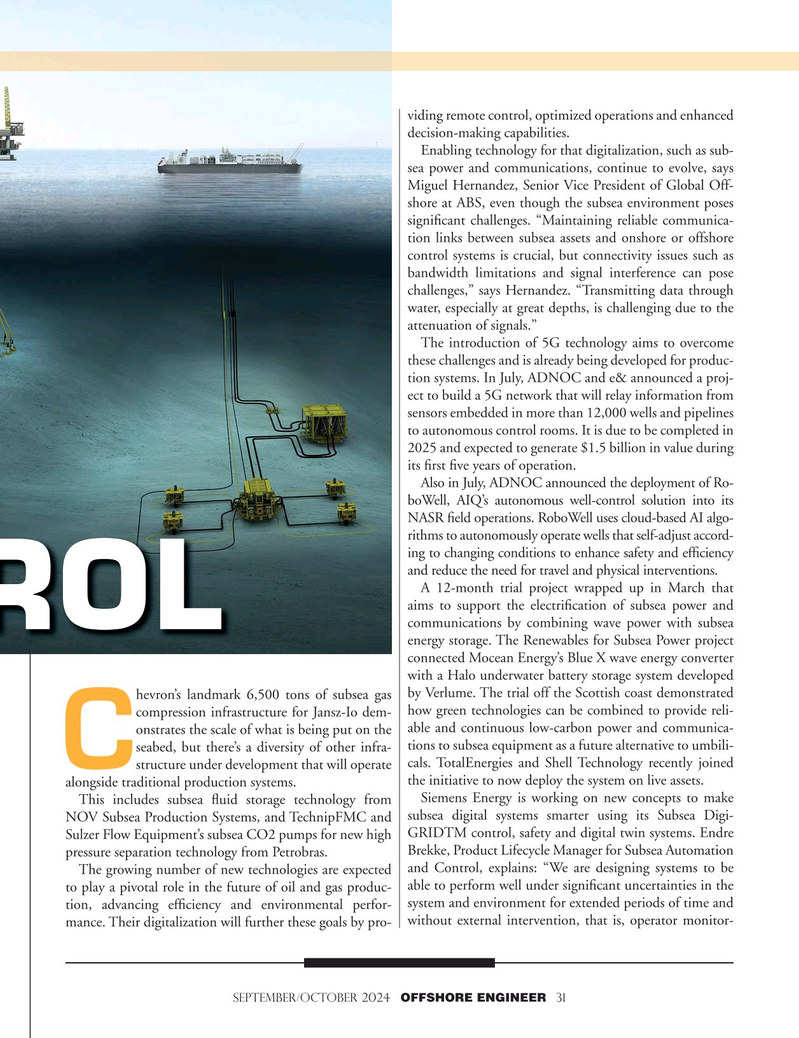
Page 31: of Offshore Engineer Magazine (Sep/Oct 2024)
Read this page in Pdf, Flash or Html5 edition of Sep/Oct 2024 Offshore Engineer Magazine
viding remote control, optimized operations and enhanced decision-making capabilities.
Enabling technology for that digitalization, such as sub- sea power and communications, continue to evolve, says
Miguel Hernandez, Senior Vice President of Global Off- shore at ABS, even though the subsea environment poses signi?cant challenges. “Maintaining reliable communica- tion links between subsea assets and onshore or offshore control systems is crucial, but connectivity issues such as bandwidth limitations and signal interference can pose challenges,” says Hernandez. “Transmitting data through water, especially at great depths, is challenging due to the attenuation of signals.”
The introduction of 5G technology aims to overcome these challenges and is already being developed for produc- tion systems. In July, ADNOC and e& announced a proj- ect to build a 5G network that will relay information from sensors embedded in more than 12,000 wells and pipelines to autonomous control rooms. It is due to be completed in 2025 and expected to generate $1.5 billion in value during its ?rst ?ve years of operation.
Also in July, ADNOC announced the deployment of Ro- boWell, AIQ’s autonomous well-control solution into its
NASR ?eld operations. RoboWell uses cloud-based AI algo- rithms to autonomously operate wells that self-adjust accord- ing to changing conditions to enhance safety and ef?ciency and reduce the need for travel and physical interventions.
A 12-month trial project wrapped up in March that aims to support the electri?cation of subsea power and communications by combining wave power with subsea
ROL energy storage. The Renewables for Subsea Power project connected Mocean Energy’s Blue X wave energy converter with a Halo underwater battery storage system developed hevron’s landmark 6,500 tons of subsea gas by Verlume. The trial off the Scottish coast demonstrated how green technologies can be combined to provide reli- compression infrastructure for Jansz-Io dem- onstrates the scale of what is being put on the able and continuous low-carbon power and communica- tions to subsea equipment as a future alternative to umbili- seabed, but there’s a diversity of other infra- structure under development that will operate cals. TotalEnergies and Shell Technology recently joined
C the initiative to now deploy the system on live assets.
alongside traditional production systems.
Siemens Energy is working on new concepts to make
This includes subsea ?uid storage technology from
NOV Subsea Production Systems, and TechnipFMC and subsea digital systems smarter using its Subsea Digi-
Sulzer Flow Equipment’s subsea CO2 pumps for new high GRIDTM control, safety and digital twin systems. Endre
Brekke, Product Lifecycle Manager for Subsea Automation pressure separation technology from Petrobras.
The growing number of new technologies are expected and Control, explains: “We are designing systems to be able to perform well under signi?cant uncertainties in the to play a pivotal role in the future of oil and gas produc- system and environment for extended periods of time and tion, advancing ef?ciency and environmental perfor- without external intervention, that is, operator monitor- mance. Their digitalization will further these goals by pro- september/october 2024 OFFSHORE ENGINEER 31

 30
30

 32
32